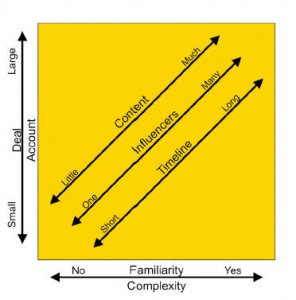B2B Marketing: Calls-to-action and the business buying cycle
One way to look at the Business Buying Cycle is to break it down into stages. There are lots of potential stages and we can talk about those stages later but let’s keep it simple for now and just use these five:
- Connect Stage: for generating demand by helping a prospect connect a business problem or goal with the possibility of a solution
- Validation Stage: for validating the worthiness of that expression of interest into a priority project
- Investigation Stage: for doing a deep dive on one or more solutions in order to figure out what to do
- Purchase Stage: for picking the right solution and negotiating the right deal and terms
- Operational Stage: for implementing or using the solution
Calls-to-action in the form of particular pieces of content should align with these stages. In other words, you need a hypothesis of the stages of the buying cycle and a hypothesis of the content that maps to each stage. If someone responds to content in a stage, marketing can use the interest in that content to score the level of interest higher.
By using this approach, B2B companies can use a call-to-action that is appropriate within the overall content marketing effort and extrapolates interest in the offer based on the stage of the buying cycle, testing and iterating to a more efficient demand generation and lead nurturing strategy
In this blog post, I will focus on four of these stages.
Connect Stage
When generating demand early in the connect stage, companies should use credible (often third-party) information about the business problem solved by their particular solution.
For example, research might reveal that problems with sales forecasting drive purchase decisions for sales force automation (SFA) software. To take advantage of this information, an SFA vendor might contract with a company with an industry reputation for providing credible information on sales forecasting best practices to write a white paper on sales forecasting, perhaps based upon field research.
On the other hand, if research revealed that chief financial officers (CFOs) were the individuals feeling the pain of faulty forecasts, perhaps a paper by a brand more familiar to CFOs would be more effective. In other words, B2B companies should keep in mind the target community when developing the call-to-action offer strategy.
Validation Stage
In the Validation stage, the offers need to perform a slightly different job. In this case, the responder has expressed an interest in the problem. Now the offers need to validate the worthiness of the solution so that it becomes a priority:
- A case study
- An exercise to assess the potential return on investment
- A webinar that features a current customer with a well-known brand
- A report by an industry analyst (e.g., the Gartner Group in the computer industry)
Response to each of these offers indicates a higher probability of purchase than the initial response to an offer about the business problem. In other words, it’s predictive of purchase intent. Again, interest in these content offers would result in a higher lead score.
Investigation Stage
In the Investigation stage of the buying cycle, customers are generally ready to speak to sales. Offers in this stage can identify those customers and prospects. For example, a prospect may want to develop a request for proposal (RFP) to send out to a short list of vendors under consideration. As such, an RFP template (biased to the solution of the vendor) might be very useful to the prospect and even highly predictive of an increased likelihood of purchase.
Likewise these calls-to-action will also indicate the customer is prepared to speak with a sales representative:
- Implementation guides
- Technical white papers
- Competitive guides
- Evaluation software
- Total cost of ownership exercises
- Other similar content
All of these relate to the concerns of customers and prospects entering into a deeper investigation of a particular solution.
Purchase Stage
Once the buying cycle has reached the purchase stage, the sales channels should primarily deliver call-to-action offers. Purchase stage offers include discounts on a product or a service, and sales representatives can use these types of offers to win deals and to expedite the purchase process. These offers should be left to the judgment of salespeople and their managers in order to avoid unnecessary discounts.
Across the entire Business Buying Cycle, vendors can also include generic offers such as sweepstakes or free merchandise to generate demand, and move prospects toward a decision. One thing to keep in mind, is unlike the more targeted calls-to-action, these offers are not as predictive of future purchase behavior.
Related Resources
Free Web clinic, March 30th — Converting Leads to Sales: How one B2B company generated $4.9 million in additional sales pipeline growth in only 8 months
B2B Marketing: The FUEL methodology outlined
How and When to Use Content in the B2B Sales Process (Members library)
B2B Marketing: Relevant content must move beyond “glitz” and tell a properly sequenced story
Content Marketing: How to get your subject matter experts on your corporate blog









